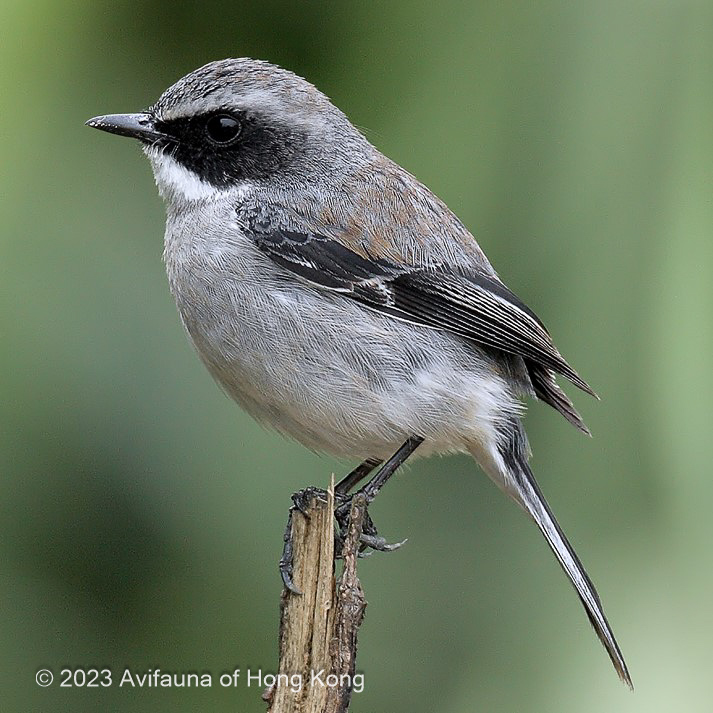Grey Bush Chat Saxicola ferreus 灰林䳭
Category I. Scarce winter visitor and passage migrant to clearings, cultivated areas and shrubland - grassland.
IDENTIFICATION

February 2010, Michelle and Peter Wong. First-winter male.
13-15 cm. Adult male is grey with a white supercilium, black mask, wings and tail and white underparts. The first-winter male is similar but has a brownish tinge to the upperparts.

February 2010, Michelle and Peter Wong. Female.
The female has warm brown head and upperparts and a buffish supercilium. The rump and sides of the tail are rufous-brown; the centre of the tail is dark brown. The underparts are buffish apart from the white throat and belly.
VOCALISATIONS
Has a variety of calls including an inflected slightly buzzing ‘hzzeeoo’ (rather finch-like), ‘hzzzzt’, or ‘shoo’ and a more nasal ‘zheet’ or ‘zrrrt’; also, a ‘chak’ call.
The song, rarely heard here, is a sweet, somewhat hurried phrase that descends in pitch from beginning to end.
DISTRIBUTION & HABITAT PREFERENCE
Occurs in open areas of open-canopy shrubland, forest clearings and cultivated fields where it readily perches on bushes and overhead wires. Favoured sites in recent years have included Shek Kong catchwater and the rice fields at Yi O on Lantau.
OCCURRENCE
Grey Bush Chat is a scarce winter visitor and passage migrant, extreme dates being 14 September (the sole record in that month, the next earliest is on 1 October) and 20 April. Small numbers are noted in the first three weeks of October, but the main period of occurrence is from the last week of October to the third week of January. Numbers decline after that although there is anomalous peak in the third week of February. Small numbers have been recorded in March and early April (Figure 1).
From 1998/99 to 2020/21 there were three winters with no records and there were single-digit totals in 14 years (Figure 2). There have been six winters of double-digit counts since 2009/10. The count of 17 birds in 2013/14 is the second highest winter total on record, the highest being 22 in the 1971/72 winter.
Carey et al. (2001) noted that highest numbers occurred in the early 1970s when there were regular double-digit totals. There was a sharp decline in the 1980s, followed by a slight increase in the 1990s and a further increase in since 2009/10. It is considered the increase since the 1990s is probably a result of increased observer activity.
Most records are of single birds although there have been a number of sightings of two to three birds together. The highest count is of four at Lam Tsuen on 31 January 1940 and at Yi O on 4 December 2015. Some wintering birds are long-staying, e.g., up to three were at Shek Kong from 15 October 2015 to 11 March 2016.
There have been a handful of records of single birds outside the period defined above but the possibility of their being ex-captive individuals cannot be ruled out. These concern singles at Tai Mo Shan on 1st and 5 July 2003, on Po Toi on 16 May 2007 and on Tai Mo Shan from 31 March to 3 June 2007.
Swinhoe (1861) noted it to be ‘pretty abundant’ in the hills during the first week of March, while Kershaw (1904), Vaughan and Jones (1913) and Herklots (1953) recorded it as a rare or occasional winter visitor. Four at Lam Tsuen on 31 Jan 1940 (Herklots 1940) were the only birds recorded during 1930-1941, and a total of four on 3rd and 13 April were the only birds that Dove and Goodhart (1955) observed. Swinhoe’s observation is at odds with subsequent records, though he may simply have happened upon an unusually marked influx.
BEHAVIOUR, FORAGING & DIET
Flies down from a perch to take insect prey on the ground. Uses bushes and man-made artefacts such as fences, posts and overhead wires as a perch. It has also been observed making short flights at passing insects in the manner of a flycatcher (Hutson 1931).
RANGE & SYSTEMATICS
Occurs from Pakistan east to central and southern China. Two subspecies are recognised. S. f. haringtoni breeds above 1,000m in China from southeast Gansu, south Shaanxi, south Anhui and Shanghai south to Fujian, northern Guangdong and northern Guangxi. In winter, a part of the population migrates to south China, including HK, and Indochina.
Nominate S. f. ferreus breeds above 1,500m from Pakistan east to Myanmar, northwest Thailand, north and central Laos, and central Vietnam, and in southwest China (southeast Tibet, and western and southern Yunnan). It winters at lower altitudes in north India, south Myanmar and south Indochina (Collar 2020).
CONSERVATION STATUS
IUCN: Least Concern. Population trend stable.
Figure 1.

Figure 2.

Collar, N. (2020). Gray Bushchat (Saxicola ferreus), version 1.0. In Birds of the World (J. del Hoyo, A. Elliott, J. Sargatal, D. A. Christie, and E. de Juana, Editors). Cornell Lab of Ornithology, Ithaca, NY, USA. https://doi.org/10.2173/bow.grybus1.01
Dove, R. S. and H. J Goodhart (1955). Field observations from the Colony of Hong Kong. Ibis 97: 311-340.
Herklots, G. A. C. (1940). Notes and comments. Ornithology. Hong Kong Naturalist 10: 122-127.
Herklots, G. A. C. (1953). Hong Kong Birds. South China Morning Post, Hong Kong.
Hutson, H. P. W. (1931). The Birds of Hong Kong. Part VII. Sub-family Saxicolinae (Chats). Hong Kong Naturalist 1: 151-152.
Kershaw. J. C. (1904). List of birds of the Quangtung Coast, China. Ibis 1904: 235-248.
Swinhoe, R. (1861). Notes on the ornithology of Hong Kong, Macao and Canton, made during the latter end of February, March, April and the beginning of May 1860. Ibis 1861: 23-57.
Vaughan, R. E. and K. H Jones (1913). The birds of Hong Kong, Macao and the West River or Si Kiang in South-East China, with special reference to their nidification and seasonal movements. Ibis 1913: 17-76, 163-201, 351-384.

